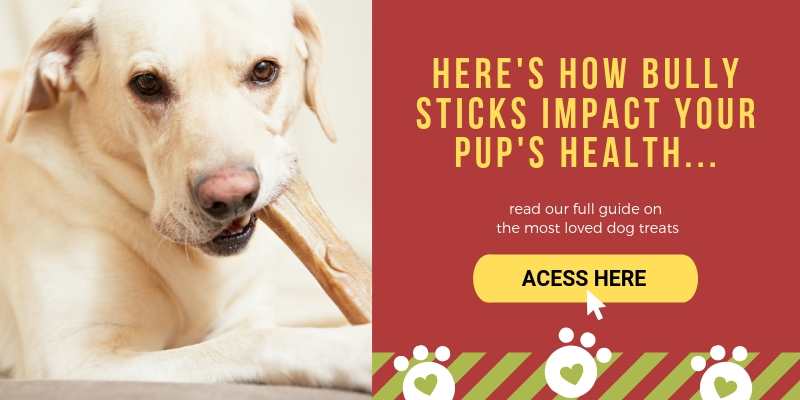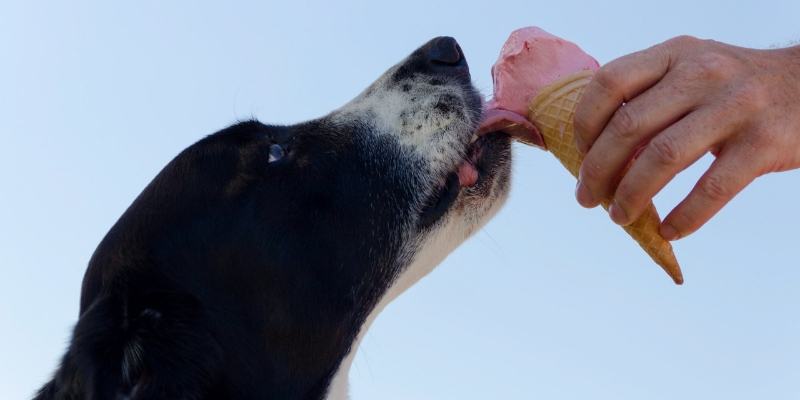Are you interested in a particular topic? Then use the table of contents below to jump to the most relevant section. And you can always go back by clicking on the black arrow in the right bottom corner of the page. Also, please note that some of the links in this article may be affiliate links. For more details, check the Disclosure section at the bottom of the page.
- How to tell if your pup underweight at all?
- Why Is My Dog Losing Weight?
- How to help a dog gain weight?
- What else can you help your pup with?
- 6 things to consider when helping your dog to gain weight
- High-calorie dog supplement: universal best choice
- Best dry dog food for weight gain and muscle
- High-calorie canned dog food
- High-fat dog food for weight gain
- High-calorie paste for dogs
- High-calorie puppy food
- How to put weight on a dog with a sensitive stomach
- High-calorie dog treats
- Homemade high-calorie dog food
Most dogs have no difficulty gulping any food that is put in front of them. Because of overeating and snacking, they are notoriously known for gaining weight quickly. And just like humans, dogs throughout their lives are susceptible to weight fluctuations.
For most dog owners, keeping their pup from becoming overweight is a constant battle. But what to do if the opposite is your main concern?

How to tell if your pup underweight at all?
First thing’s first… Instead of making important decisions about your dog’s health by yourself, always stay in touch with your vet.
The great news is there are some clear indications of a dog the must have some high-calorie meals to bulk up.
Among those are:
- Bones sticking out, particularly ribs and shoulders
- Worsen coat condition
- Loss of interest in food
- Lack of strength and objection to going for a walk
- Diminished motivation almost the same as human depression
If you recognize any of these distressing symptoms, there is no need to panic instantly… Some breeds, for instance, have very low-fat stores. Visible bones in such dogs do not unmistakably point out that they demand to put on weight.
If you have any cause for concern, the practical thing is to visit the vet and talk with him about the possible plan of actions.

You might also like:

Why Is My Dog Losing Weight?
Weight loss is usually a sign of an underlying health problem. Dysfunction of organs is a common cause. Dogs with thyroid, liver, pancreas, and intestines issues are known to experience some form of weight loss.
Invasions of parasites can also lead to weight loss. Worms will use the food your dog consumes to thrive within their digestive tract. The essential nutrients will be stripped out of the food, leaving less for the pet’s well-being.
It’s critical to make a visit to the vet to get a better understanding of what’s going on with your dog. Your doctor will perform tests that can diagnose your dog so you can give them the treatment they require.
Since weight loss is a gradual process, for quite a while, it often goes unrecognized. Look at the shape of your dog from above. Do you see a smooth slope from the rib cage to the belly? Then all good. But if it’s not, then refer to the symptoms mentioned in the previous section to confirm or reject your suspicions.

How to help a dog gain weight?
There is a contrast between giving a helping hand to your dog’s metabolism and supply him with an infinite amount of food so that he gets overweight. It’s just as dangerous as being too thin.
As with any adjustments in your dog’s nutrition, advising the vet first always pays. Instead of going for a radical overnight transformation, it is equally necessary to implement any changes gradually.
To put on weight, your dog needs to eat more calories than it burns off. This alone will guarantee that the pup gains weight as long as there is no pressing medical predicament.


What else can you help your pup with?
- Feed your dog often: by supplying your dog smaller servings much more often, the pup may end up eating more than if you try to stick all the calories in one go.
- Include high-calorie supplements into pet’s diet: there is no replacement for a staple diet of your pup. But treats and supplements have their place, especially in the cases when the dog needs some extra to gain weight.
- Try a free-food approach: just leave food out at all times so that when your furry companion is starving, he can dig in.
- Choose high-calorie foods, also rich in proteins: instead of concentrating purely on fat that can bring along associated health dangers, provide your pup with healthier options. Read on for some great examples.

6 things to consider when helping your dog to gain weight
It’s a drastic change for any dog to add even a few pounds of weight. You don’t want to do anything that might potentially cause harm to pup’s well being. Keep the following things in mind to make sure your dog goes the weight gain journey healthily:
#1 Quality Over Quantity.
Your first impulse to add calories to the daily intake of your dog may be to add extra food to his bowl. While there may be a requirement for a small rise in food volume, too much of it may be a questionable strategy. Dogs are routine creatures. They also have delicate bellies. So food overloads may lead to stomach problems and disastrous bloat if your pup.
#2 Making the switch to a dog food designed to build mass is best.
These foods are stuffed with healthy ingredients. They are also dense in nutrients in most cases. So to see results, you will not have to make a massive difference in the serving size of your pup.
If you plan to increase your dog’s food supply, consider dividing it up over the day. Multiple small meals are much better than just one large meal. Your canine will be more energetic and have plenty of time to digest the food.
#3 Looking at the ingredients.
All-natural ingredients are used in holistic foods. They do not include preservatives, artificial colors or flavors, and tend to be filled with healthy fats.
This kind of food places substantial importance on top-notch components, and you will usually notice an excellent fat source on the top of the ingredients list.
The fact that holistic food includes “good” healthy oils is another of its benefits. Whether it’s fish oil rich in omega-3 fatty acids or high-caloric flaxseed oil – both of those are ensuring that your dog gets the necessary nutrients.
Protein is a crucial ingredient for muscle development that your dog needs. You should provide canine with food consisting of 30% protein at the very least. The larger this number, the better. Stay away from harmful by-products with less than the same amount of amino acids and stick to natural meat.
Another thing about reading the label of the pup’s food: select options with formulas you get. Clearly listed and named components are invariably better than vague, hard to pronounce, or questionable ingredients.
#4 Be patient and take things slowly.
Sudden changes in the diet are amongst the worst things you can do for your dog right now. The pup didn’t lose the weight overnight, so getting it back is a long process. Make diet modifications step by step. Begin with adding to standard pups food a bit of the new. Then add a bit more over a few days if a pup’s fine with adjustments. This will give plenty of time for your pet’s digestion to get used to changes. That means fewer stomach problems and fewer messes for you to clean.
#5 Stay out of junk food.
Fatty treats just for the sake of boosting that calories number is as bad for dogs as for humans. Those are empty calories that won’t do your dog any services. While some fat is healthy, it can provoke even more problems.
You want your dog gaining that weight by growing more muscles, not increasing the fat storages. Go for a protein-high choice with low levels of useless carbs. A small serving of such treats is a good idea.
#6 Don’t forget about the supplements.
Those will quickly turn your dog’s regular food in more nutritious and sometimes more appealing food option. These products are accessible in different kinds to satisfy your dog’s needs: pills, treats, or even liquids. But like with all other supplements, it makes sense to ask your vet first and strictly follow the directions for serving to assure that your canine grows a healthy weight.
Overall, there are many methods to support your dog in gaining healthy weight. And it’s completely possible for your furry companion to build muscles on a high-calorie diet instead of having stomach problems. And doghint.com is on a mission to find your best options to win the dog gaining weight battle. We crawled Amazon.com back and forth, analyzed all best and worst rated products in the high-calorie dog food department and came up with the following list:

High-calorie dog supplement: universal best choice
It takes only 7 gram of to add 40 calories to your pups nutrition plan effortlessly. This supplement is developed to assist your pet in achieving the perfect mass, along with consuming vital nutrients and proteins. Recommended for picky eaters, underweight dogs and works well for ALL BREEDS.
Some pet owners might find the smell of this product offputting. But what’s important is whether or not your pup likes it. And as some pet owners, who purchased this product pointed out even their dogs tend to be very picky eaters and turn their noses up to most food with this supplement all the worries about low-calories intake are gone with this weight gainer, because furry friends seem to enjoy it a lot.
Some numbers: calories per serving (7g) – 40, including 30 cal from fat (3g per serving). One scoop of the product also includes 1g of carbs and 2g of proteins.
Check more reviews shared by Amazon buyers .

Best dry dog food for weight gain and muscle
Bully Max High-Performance Super Premium Dog Food
This product includes menhaden oil. Menhaden is a tiny herring-related sea fish. Their oil is rich in EPA and DHA omega-3 fatty acids essential both for humans and pets. This product is suitable for any breeds and ages (starting from 1 month) and all ages (4 weeks and older), and as the manufacturers say, it could be the only meat-based recipe (with 30 % of protein and 20 % fats) in the category of dry dog foods for weight gain.
It appears to be a bit expensive, but if you make some counting (USD per calorie), you will understand that the price is very competitive. This product boasts with 535cal per cup.
Check more reviews shared by Amazon buyers here.

High-calorie canned dog food
There are numerous choices in Purina Pro Plan Wet Dog Food, but depending on the components and nutrients, Chicken & Rice continue to be the finest if you are searching for high-calorie canned meals. This one is 437 kcal per can. It offers 23 different vital nutrients along with Omega-6 fatty acids for silky coat and it boasts of being produced with high-quality ingredients and lists the real chicken as the most important one.
Here are some numbers: minimum 9% of crude protein, min 6% of crude fat, maximum 1.5% of crude fiber. 437 kcal per can.
Great things about this food that dogs love it and it also might help to solve some other issues other than gaining weight. Some buyers reported that it helped to get read of “licking yourself” problem.
Check more reviews shared by Amazon buyers .

High-fat dog food for weight gain
This meat-based, natural protein and fat-rich formula by Ketogenic Pet Foods is mind-blowing. Not only it has a whopping 46% fat content (perfect if you are looking quality fatty food), but the ingredients list is simply awe-inspiring. The main protein is chicken. And the formula also features Coconut Oil, Avocado Oil, Rice Bran Oil, and a HUGE list of supplements – including taurine (that is important for any grain-free recipes). So if you are looking for a natural fatty recipe and cautious about potential risks of grain-free diet for your pup this product is literally can’t get any better.
Some numbers: guaranteed analysis: 35% protein, 46% fat, 0.5% fiber, 0.2% taurine. calories per cup: 251
Check more reviews shared by Amazon buyers .

High-calorie paste for dogs
Made of corn syrup, soybean and cod liver oils, this nutritious fatty paste is known and trusted to be an efficient calorie booster. It works well for picky eaters, aging pups, and stressed animals, going through severe illnesses.
Whether you’ll mix the paste in pup’s food or just give it as it is, your dog most likely will be pleased with the taste. And just a tiny teaspoon of the product will add up 28 calories to your pet’s daily intake. That’s a no brainer.
Some numbers: 28 calories per teaspoon. Crude protein: 0.2% min, crude fat: 30% min.
Check more reviews shared by Amazon buyers .

High-calorie puppy food
Veterinarian has created the recipe of this puppy weight gainer. This high-calorie dietary supplement offers nutrients in a delicious gel. One teaspoon can add up 20 calories to the puppy’s diet, which is a lot, taking into consideration his overall calories’ intake.
Here’re some more numbers: from those 20 calories, 0.68% come from protein, 28.14% – from fat. And there are a lot of essential nutrients in the product: phosphorus, potassium, magnesium, iron, iodine, Vitamins A, B1, B2, B12, D… And that’s just to name a few.
The good part: puppies LOVE it!! Another good thing to mention this product works miracles for smaller breeds as it keeps their sugar levels intact. And if you are an owner of a small breed dog, you know that being hypoglycemic is a frequent problem.
Check more reviews shared by Amazon buyers .

How to put weight on a dog with a sensitive stomach
“Sensitive stomach is a generic and vague term,” says veterinarian Dr. Patrick Mahaney.
Such condition can result in anything from gasses to diarrhea.
And it’s common for dogs partly because they are very curious and are exploring the universe through all their senses, including taste. Some breeds like the Scottish Terrier and the Yorkie are more susceptible to this. Older dogs and puppies are also at a higher risk here. And that’s the reason why sometimes the dog’s owners are struggling with never-ending quest to find a proper diet that their pup will accept and enjoy. And if you also have to fix the issue of putting on weight this search gets even more perplexing. Well try this:
Dyne High-Calorie Liquid Dietary Supplement
It offers an additional 150 calories per ounce, it assists in different stress-related situations including picky eaters, underweight dogs, dehydrated or geriatric dogs, and even pregnant and lactating dogs. It has a taste that pups love and overall appears to be an excellent fit for canines with sensitive stomachs, according to dog owners experiences.
Check more reviews shared by Amazon buyers here.

High-calorie dog treats
These single-ingredient grass chicken bully sticks are fantastic for bigger breeds and can be considered among the perfect high-calorie dog treats (approximately 35 calories per stick). With 80% of protein content and supporting the dental health of the pup, these natural bully sticks are an excellent option when you have to take care of your dog gaining some weight without any hassle or health hazards. Those sticks are so much safer than typical rawhide bully sticks. Another extra bonus in case your dog gets TOO playful sometimes and may make your living rooms look like a post-tornado venue – those bully sticks will calm your little Tasmanian devil down for sure.
Check more reviews shared by Amazon buyers .

Homemade high-calorie dog food
Looking for a homemade solution to mass-produced high-calorie dog food options? This recipe, packed with calories, protein, and amino acids, can be produced with just a few components. And your pup will most definitely enjoy it.
The greatest thing about this recipe is that it is very adjustable. You can change it to suit the particular requirements of your dog. It can be prepared in advance, kept in the freezer, and given raw to hungry dogs of all ages.
Weight gain dog food recipe
Heres what you’ll need:
- Oatmeal
- Eggs
- Ground beef
- Wheat germ
- Oil
- Powdered gelatin
- Molasses
- Salt
And here’s how you make it:
Start by blending the wheat germ and oatmeal. Once mixed smoothly, add the salt, oil, eggs, and molasses. Keep mixing until you got a thick homogenous paste. Sprinkle it with gelatin and add the beef. Keep mixing.
The desired consistency you have to achieve would be similar to meatloaf.
After getting there, divide the meal into serving-sized balls. You can feed this to your pup right away or pack it into a bags and put it into a freezer for future feeding.
Even though this is an outstanding recipe for the purpose, note that your dog’s nutrition has to be diverse and well-balanced. That’s why it’s crucial to mix both homemade and professionally developed high-calorie formulas.
Thanks for the blog graphics: Canva.com


